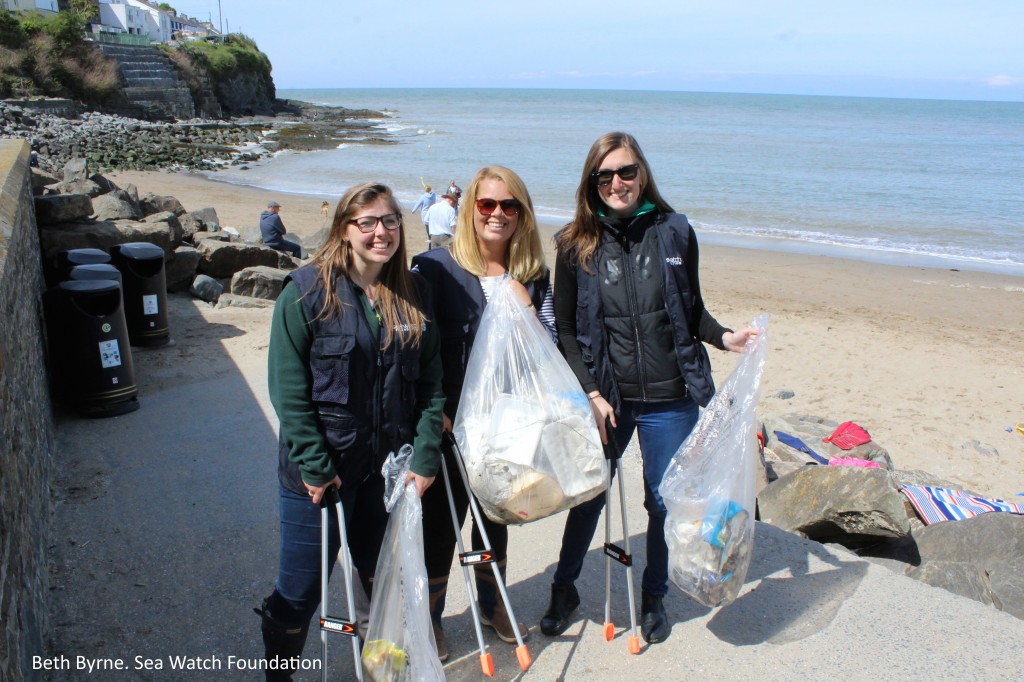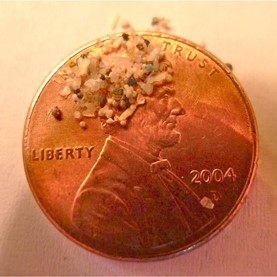Written By Stephanie Sardelis, May 21 2015
Saturday was a stunning, warm and bustling day here in New Quay, Wales. While visitors lounged on the beach and snacked on ice cream, our Sea Watch interns were happily scanning the local beaches for unwelcome waste. Four large bin bags and a mysterious traffic cone later, our interns had the chance to engage with any keen beach-goers, describing why shoreline cleaning should become a regular activity. Supporting the “2 Minute Beach Clean” initiative running nation-wide across the UK, our relatively small clean was a huge success!
Sea Watch Volunteers Beth, Meg & Steph
Daily, we are told to recycle our waste and reduce our plastic usage. With the “live green” mentality growing stronger on an international scale, we are driven to take more accountability for our garbage production and how we treat our environment as individuals and as a community. However, accepting this responsibility can be harder than it sounds if you are not entirely sure where plastic goes when you are finished with it or why littering is dangerous for wildlife. Making the answers to these questions common knowledge is the first step to successfully protecting our oceans and all of the amazing critters that live in and around it. As the renowned oceanographer, Dr. Sylvia Earle, astutely says, “people can’t care if they don’t know!”
Let’s imagine that you have just returned from the grocery store with three apples in a small plastic produce bag. You are quite certain that the clear bag is too small to be reused in your rubbish bin and too weak to transport your lunch to work. So, you bid your bag adieu after only a short 30 minutes of use, and place it on the top of your recycling bin pile in the yard. Returning to the warmth of your kitchen, you fail to notice the large breeze that sweeps through your garden, catching your plastic bag and carrying it off on an unfortunate adventure. The wind may carry this seemingly harmless bag into a nearby stream, which all eventually course into lakes and rivers leading to the ocean. Or, the plastic bag could easily fall through a sewage drain, which also leads directly into our waterways and eventually into the ocean. Your plastic bag will drift at the surface of the ocean, carried around the entire globe by the ocean’s currents.
Now, amplify that imaginary plastic bag scenario by 500 billion. It is shocking, but that number is not an exaggeration: Plastics Europe estimates that one million plastic bags are used every minute around the globe, totalling 500 billion used annually.
Don’t believe your garbage could possibly travel around the entire world? In 1992, a shipping container filled with thousands of rubber ducks fell into the Pacific Ocean off the coast of China. Fifteen years later, after travelling through the Arctic, Antarctic and Atlantic Ocean, the ducks began washing up onto the beaches of the United Kingdom – what a journey!
Once in the ocean, there are two major ways plastics jeopardise the lives of marine creatures at sea: entanglement and consumption.
Entanglement occurs when marine animals get caught in debris. This can inhibit proper eating and swimming, potentially becoming fatal. Fishing lines, six-pack rings from drinks, cable ties and excess rope can wrap around the necks, fins and tails of many marine species. Whales, dolphins, seals and seabirds are only a few of the animals commonly bound by wasted plastics. While many organisations are dedicated to disentangling marine animals, such as the British Divers Marine Life Rescue, the rate at which entanglement is occurring due to plastic pollution is simply too rapid. Read about the British Divers Marine Life Rescue and their disentanglement efforts here.
For marine animals, eating plastic can be deceptively dangerous; if the animals do not initially choke on the manmade substance, it will sit in their stomachs indigestible, making them feel full and preventing their intake of vital nutrients. This likely and devastatingly leads to starvation. Leatherback turtles, which “arrive from their nesting grounds in the Caribbean to refuel on the United Kingdom’s abundant seasonal jellyfish blooms”, can all too easily mistake floating plastic bags for jellyfish (Marine Conservation Society, UK). Otherwise, if the plastic is not eaten whole, it will be degraded by wind, waves and UV sunlight into plastic particles. These particles are microscopic in size and, during breakdown, release any toxins that were added to them into the surrounding waters, such as fire retardants to make them microwave-safe. These poisonous microplastic particles quickly become small enough to be undistinguishable from plankton. Plankton are the miniscule creatures which act as the start of all ocean food chains, consumed by anything from small fishes, crabs and invertebrates. Biomagnificaiton describes how the amount of plastic toxins increases as one moves up the food chain. In other words, if a small fish eats one piece of microplastic, storing the associated toxins, and a medium fish eats 10 of those small fish, then the medium fish will have accumulated ten times the amount of plastic toxins. If a sea lion then eats 10 of the medium fish, the scale of toxicity skyrockets to 100 times as many toxins.
Infographic: www.mercurypolicy.scripts.mit.edu/blog/?p=499
Marine animals are not the only species at risk of ingesting harmful, potentially poisonous plastics. Due to our love of seafood, humans sit atop most marine food webs. We consume a resounding number of large fish species such as tuna and salmon with high levels of biomagnified toxins. Eating animals that have accumulated plastic toxins over their lifetime in the ocean can enable these toxins to transfer to humans, leading to many serious health issues including various cancers, developmental issues during pregnancy, and hormonal disruption causing unstable immune systems, to name a few.
Plankton also acts as the major food source for many filter-feeding megafauna such as humpback, fin and blue whales, basking and whale sharks, and manta rays. These animals can consume thousands of pounds of plankton daily. While unknowingly feeding on plankton or other fish, marine megafauna accumulate shocking amounts of deadly microplastic particles. For example, in 2013, a sperm whale washed ashore along the coast of Spain with 17 kilograms of plastic in its stomach, undoubtedly the cause of its death. Click here for more information.
While the subject of plastic in our oceans seems downright dreary, there is always a silver lining! We all have the capability to aid in the removal of plastics from our oceans, thereby protecting our environment, wildlife and selves. Here are our “3 R’s of the Ocean” that you can easily follow to improve the cleanliness of our oceans!
REDUCE
Picking up garbage from the shoreline is one of the simplest ways to prevent it from entering the ocean. Beach cleaning events are run regularly all over the United Kingdom, eager for your participation! Here are a few examples:
- Surfers against Sewage
- Marine Conservation Society UK
- Morebambe Bay, Lancashire
- Clean Cornwall
- National Trust
- Keep Scotland Beautiful
- Keep Wales Tidy
- Keep Britain Tidy
If you are a go-getter, try organising your own shoreline clean! Here are some helpful tips to get you started!
Alternatively, if you are more of a casual beach-goer, you can try a “Two Minute Beach Clean”, a UK-based initiative to ameliorate the United Kingdom’s over 19,000 miles of coastline. Share your progress online @2minutebeachclean on Instagram or with the hashtag #2minutebeachclean on Twitter, and see how others are helping nationally!
REUSE
Using items such as water bottles and coffee mugs that can be used over and over is the best place to start. And, rather than throwing unwanted plastic away, find secondary uses for it. Yogurt, butter and ice cream containers are perfect for storing leftovers, plastic bottles can be easily crafted into bird feeders, and bottle caps are great for children’s crafts! Get creative!
REFUSE
When shopping or dining out, always refuse (politely) plastic bags, bottles and containers. Good habits to adopt include bringing reusable grocery and produce bags to the store, taking a set of cutlery to take-out restaurants, and never using straws and coffee-lids! For more ideas, visit the “Plastic Free July” website.
Interested in learning more about plastic pollution? Check out: www.plasticoceans.net



























